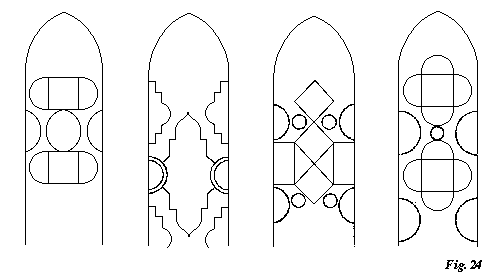442 APPENDIX TO PART II
4
DIJON, 29th May.
DEAR OLDFIELD,-You will be surprised at not hearing from me, but indeed I have had little time; the afternoons in this country are so lovely that I cannot miss my walk, and we travel all the mornings. I write, however, hurriedly, to put you in mind of what I forgot to mention in my last letter-Ward’s rosette, joining his circles in the long light. It was vulgar and disagreeable in the last degree. I hope it is not too late to alter it. I send these patterns, fig. 1 [below], merely to give you some types of the class of ornament employed in the Chartres glass, and of what I think may be called good manner in this kind of decoration, as opposed to Ward’s flourishes. You will observe the rudeness and bluntness of the pattern: its sharp angular lines, and delicate introduction of bars of one colour on fields of another. As a further standard I send fig. 2 [p. 443],
 |
faithfully copied in Rouen Cathedral, in which you will see how full the circles are of figures, how rude and undistinguishable these figures are, and how coarse and severe the species of ornament by which the circles are joined.
I send this, also, because it gives an example of the border which I recommended for this light, and which I find frequently repeated, and always with good effect. I don’t send the circular and square patterns as good; for indeed I saw no isolated figures of this kind in either Chartres or Rouen. The figure subjects are always put close together, and linked by a pattern which interferes with, and is part of, them, as in the example I send; so that I have been obliged to adapt their decorations to these three patterns; the Chartres windows are all filled in this sort of way, each large space having figure subject. I send you the Albert Dürer, and hope the face won’t be quite rubbed out on the way; but as it is to be so small it does not much matter. I have put in the seven lamps, because I think them sufficiently
[Version 0.04: March 2008]